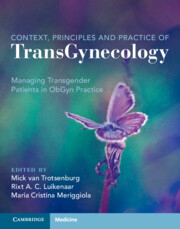Book contents
- Context, Principles, and Practice of Transgynecology
- Context, Principles, and Practice of Transgynecology
- Copyright page
- Dedication
- Contents
- Foreword
- Preface
- Contributors
- Abbreviations
- Section A Contextual Transgynecology
- Section B Practicing Transgynecology
- Section C Gynecological Surgery for Transgender Males
- Section D Sexuality and Contraception
- Section E Fertility and Reproduction
- Chapter 24 Fertility Counseling for Transgender and Nonbinary People
- Chapter 25 Management of Fertility for the Trans Masculine Individual
- Chapter 26 Fertility Maintenance for Trans Women
- Chapter 27 Fertility Prospects Related to Puberty Blocking Therapy
- Chapter 28 Medico-legal Entanglements of Assisted Reproduction
- Chapter 29 Obstetrical Care for Trans Persons
- Chapter 30 Uterine Transplantation for Trans Women: Prerequisites and Limitations
- Section F Impact of Gender-affirming Hormonal Therapy on Genital Organs
- Section G Screening and Prophylaxis
- Transgynecology Index
- References
Chapter 27 - Fertility Prospects Related to Puberty Blocking Therapy
from Section E - Fertility and Reproduction
Published online by Cambridge University Press: 22 December 2022
- Context, Principles, and Practice of Transgynecology
- Context, Principles, and Practice of Transgynecology
- Copyright page
- Dedication
- Contents
- Foreword
- Preface
- Contributors
- Abbreviations
- Section A Contextual Transgynecology
- Section B Practicing Transgynecology
- Section C Gynecological Surgery for Transgender Males
- Section D Sexuality and Contraception
- Section E Fertility and Reproduction
- Chapter 24 Fertility Counseling for Transgender and Nonbinary People
- Chapter 25 Management of Fertility for the Trans Masculine Individual
- Chapter 26 Fertility Maintenance for Trans Women
- Chapter 27 Fertility Prospects Related to Puberty Blocking Therapy
- Chapter 28 Medico-legal Entanglements of Assisted Reproduction
- Chapter 29 Obstetrical Care for Trans Persons
- Chapter 30 Uterine Transplantation for Trans Women: Prerequisites and Limitations
- Section F Impact of Gender-affirming Hormonal Therapy on Genital Organs
- Section G Screening and Prophylaxis
- Transgynecology Index
- References
Summary
Pubertal suppression is a treatment option for minors with gender incongruity and dysphoria and is recommended by the World Professional Association for Transgender Health (WPATH) and Endocrine Society. Unfortunately, there are limited data regarding the effect of gonadotropin-releasing hormone (GnRH) agonists, or “puberty blockers,” on future fertility in transgender and nonbinary youth. In this chapter, we will describe the potential consequences of GnRH agonist use for puberty blockade on later fertility, fertility preservation options depending on sex assigned at birth, and ethical implications in fertility preservation counseling before prescribing puberty blockers in adolescents.
- Type
- Chapter
- Information
- Context, Principles and Practice of TransGynecologyManaging Transgender Patients in ObGyn Practice, pp. 201 - 205Publisher: Cambridge University PressPrint publication year: 2022



